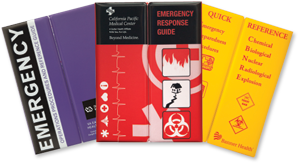The History of Uniform Emergency Codes in Ontario Hospitals
Written by: Martin Green
I first started working in healthcare security at St. Joseph’s Healthcare System in the west end of Toronto in 1985. I had only been working in the security industry since 1978 and I was still very junior. My security experience was as a “loss prevention officer” catching shop-lifters for Eaton’s department store at their flagship store at Young & Dundas.
When I started at the hospital, I soon became involved with emergency planning and procedures. As I started becoming more involved in this, I noticed that we used codes to communicate emergency situations to our staff. The code would be paged overhead from our switchboard and appropriate staff would respond as required. We made overhead announcements primarily for fire alarms, cardiac arrests, missing patients, and violent situations. What struck me about the way this was done was that the codes were all formatted differently. For example, a fire alarm was announced as “Doctor Red,” a cardiac arrest was a “Code Blue,” and a violent situation was “Code 710.”
It was my belief that it would be easier if the codes were all formatted the same way –either they would all have a number, or a doctor, or a colour assigned to them. I preferred the “Code Colour” format and started to investigate the possibility of converting all of our codes to this format. I reached out to other hospitals to see how their codes were set up. That in itself proved to be a challenge.
In the late 80s, there was no Internet, no email, no Google. There was just a book called “The Yellow Pages.” I started out by looking up ‘hospitals’ in the book which gave an alphabetical listing of every hospital in Toronto. One by one, I started calling every hospital in the city and asked to speak to the security manager. Again, keeping in mind what year this was, this proved to be a significant challenge as many hospitals did not have a security manager. Depending on the hospital, I was connected to the maintenance manager, the finance department, human resources, housekeeping, or an on-site security guard. Occasionally I got lucky and was connected to an actual security manager.
When I was finally connected to someone, I introduced myself and explained that I was conducting research on emergency codes and asked if it would be possible for them to tell me what their emergency codes were. Regardless of who I ended up talking to, I hit many obstacles. The most common answer was, “They are secret, and we don’t share them with outsiders.” When I got that answer — which was frequently — I mentioned that many nurses, doctors, and security guards worked at multiple hospitals and it could be confusing for them to remember the various codes in different hospitals.
Eventually, I was able to determine that most other hospitals were in the same situation as I was. As with St. Joe’s, there was no uniformity in how codes were announced. Additionally, I discovered that a fire alarm, cardiac arrest, missing patient, or violent situation were called something different in every hospital. Thinking back to the reality that many staff worked at many different hospitals, I felt that it would make sense if every hospital used the same term and code for every code. If a cardiac arrest is called a “Code Blue” in one hospital, it should be called a “Code Blue” in EVERY hospital.
I then set about the task of trying to create a uniform code system that I could implement for St. Joe’s. I liked the “Code Colour” format and started working on that. Some of them were easy: “Code Blue” for Cardiac Arrest, “Code Red” for fire, and “Code Green” for evacuation. However, that was as far as I was able to go. Firstly, I wanted to use primary colours — no “Code Fuchsia” or “Code Magenta”). Secondly, I was still very inexperienced in healthcare and emergency management. I didn’t have the background or training necessary to pull this off.
This is where my “partner” came in. Through my work at St. Joseph’s, I had been introduced to a gentleman named James Hanna. Jim was a well-known and respected emergency management consultant. He had extensive experience in the industry with the Provincial Ambulance Service. He conducted emergency planning training seminars and had authored the book, “Disaster Planning for Health Care Facilities.”
I reached out to James and explained what I was trying to do. He was intrigued by the idea and questioned why no one had ever thought about doing this before. Together, we worked on it for a while and James created the final listing. The interesting idea that he had was to link the code with a specific colour that added relevance to the code and, therefore, should be easier for staff to remember:

James presented the final result to the Ontario Hospital Association. He worked with them and they endorsed the codes and recommended that all Ontario hospitals adopt the codes. This led to the codes being adopted in every hospital and healthcare facility in Ontario and eventually across Canada.
Over the years, a few additional codes have been added for hostage situation (Purple – “Purple with rage!”), active attacker/shooter, (Silver – Colour of many guns), and some sites have also added codes that are for site-specific emergencies. “Code Grey” has expanded to include a facility-related infrastructure emergency such as a power failure, flood, telephone system loss, or internet loss, among others.
Interested in the uniformity of hospital emergency codes in the United States? Check out the article, “10 Most Common Hospital Emergency Codes and Their Meanings“
This article is shared with consent from Campus Safety – If you appreciated this article and want to receive more valuable industry content like this, click here to sign up for Campus Safety’s FREE digital newsletters!







